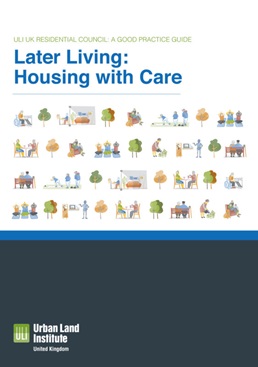Later Living: Housing with Care

ULI UK Residential Council: A Good Practice Guide
Driven by long-term demographic changes and a chance to invest responsibly, billions of pounds from insurers and pension funds are set to pour into the UK’s emerging housing with care sector, according to the Later Living: Housing with Care guide, published today by the Urban Land Institute (ULI).
Institutional backing of housing with care could move the sector from being predominantly sales-led to an operational long-term income model, with a focus on the quality of management and provision of services and amenities, according to the guide.
The UK’s rapidly ageing population, with one in four Britons predicted to be 65 or over by 2037, is creating a clear need for more significant provision of housing with care for older generations, which could alleviate pressure on public services like the NHS.
Research shows those living in properties with provided care run by the ExtraCare Charitable Trust, saves the NHS £1,994 per person on average over five years, reducing NHS spending for residents by nearly two fifths.
The ULI guide sets out best practice and innovation within this emerging sector for funders, developers, architects, and operators.
Given that these developments will be housing the elderly, providing quality care facilities alongside other amenities will be crucial. Professional operations and management will be essential, such as the provision of staff and 24-hour care, allowing residents to maintain their independence for longer.
Changing tastes among the elderly will have to be catered for as well, with the baby boomer generation wanting to pursue an active and fulfilled lifestyle in old age. Combining good design principles with activities, enlivening initiatives and staff training is vital to creating aspirational places to live in environments where residents feel happy and supported.
The report also outlines that precise legislation and planning guidelines that apply specifically to organizations that build and operate housing with care developments will be needed to meet the demand of an aging population.
As it stands, the patchwork of legislation governing the sector poses challenges. It creates a complicated process for housing with care operators to achieve planning and deliver the quality of homes and care needed.
Sector-specific legislation and regulation will provide a more straightforward and more stable set of rules, which both increase consumer confidence and provide much-needed clarity and consistency for developers, operators, funders and other stakeholders.
Despite the lack of legislation, the UK has the added advantage of a blank canvas to develop a thriving later living sector akin to the mature markets overseas.
Through a combination of more precise legislation, planning guidelines, good design, and well-managed operations, housing with care has the potential to be a fast-growing asset class following the success of Build To Rent and student accommodation.
Author: Urban Land Institute
Book Summary: Driven by long-term demographic changes and a chance to invest responsibly, billions of pounds from insurers and pension funds are set to pour into the UK’s emerging housing with care sector, according to the Later Living: Housing with Care guide, published today by the Urban Land Institute (ULI).
Institutional backing of housing with care could move the sector from being predominantly sales-led to an operational long-term income model, with a focus on the quality of management and provision of services and amenities, according to the guide.
The UK’s rapidly ageing population, with one in four Britons predicted to be 65 or over by 2037, is creating a clear need for more significant provision of housing with care for older generations, which could alleviate pressure on public services like the NHS.
Research shows those living in properties with provided care run by the ExtraCare Charitable Trust, saves the NHS £1,994 per person on average over five years, reducing NHS spending for residents by nearly two fifths.
The ULI guide sets out best practice and innovation within this emerging sector for funders, developers, architects, and operators.
Given that these developments will be housing the elderly, providing quality care facilities alongside other amenities will be crucial. Professional operations and management will be essential, such as the provision of staff and 24-hour care, allowing residents to maintain their independence for longer.
Changing tastes among the elderly will have to be catered for as well, with the baby boomer generation wanting to pursue an active and fulfilled lifestyle in old age. Combining good design principles with activities, enlivening initiatives and staff training is vital to creating aspirational places to live in environments where residents feel happy and supported.
The report also outlines that precise legislation and planning guidelines that apply specifically to organizations that build and operate housing with care developments will be needed to meet the demand of an aging population.
As it stands, the patchwork of legislation governing the sector poses challenges. It creates a complicated process for housing with care operators to achieve planning and deliver the quality of homes and care needed.
Sector-specific legislation and regulation will provide a more straightforward and more stable set of rules, which both increase consumer confidence and provide much-needed clarity and consistency for developers, operators, funders and other stakeholders.
Despite the lack of legislation, the UK has the added advantage of a blank canvas to develop a thriving later living sector akin to the mature markets overseas.
Through a combination of more precise legislation, planning guidelines, good design, and well-managed operations, housing with care has the potential to be a fast-growing asset class following the success of Build To Rent and student accommodation.
Author: Urban Land Institute


